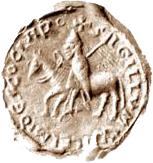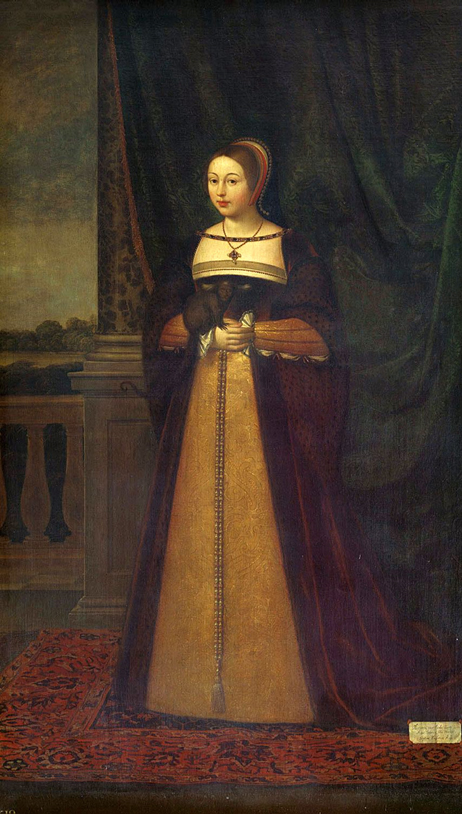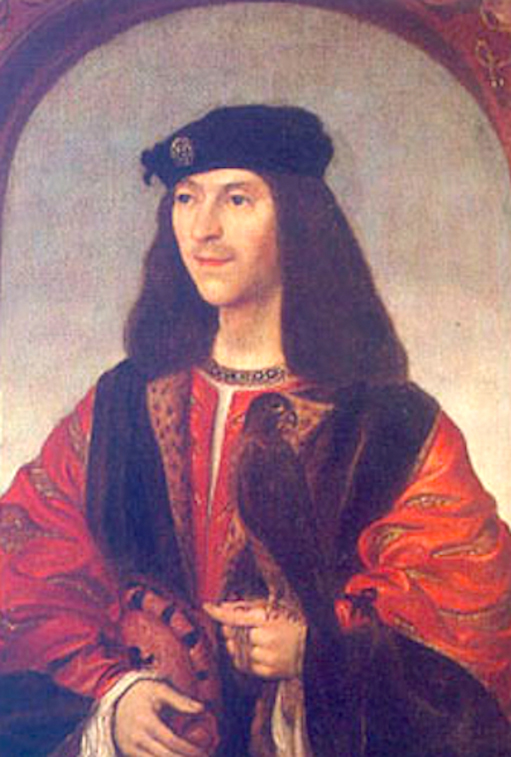Patrick Sinclair of Spotts and Woodhouselee
Patrick was held in high favour at the Scottish court, firstly with King James IV and his English wife, Margaret Tudor, then subsequently with their son King James V, in a career spanning over forty years. He was an illegitimate son of Edward Sinclair of Dryden, a branch of the Roslin family. His half-brothers, Sir John and William, were also royal servants who likely enabled Patrick’s employment at court. There is little doubt, however, that his career eventually eclipsed those of his siblings.
Probably born in the early 1480s, he first appears in the records on 12 March 1500-1 when a precept of legitimation was granted in the King’s name, describing Patrick as a ‘servant of our sovereign Lord.’ In July 1501, when the King travelled to Threave in Dumfries and Galloway, the treasury issued Patrick with 40 French crowns ‘to furnish the King’s purse.’ On 23 March 1502-3, James IV granted Patrick a tenement of land in the town of Linlithgow, ‘for the service of his close friend.’
As part of thirteen-year-old Margaret Tudor’s welcome to Scotland in 1503, the thirty-year-old King James IV arranged a pageant at Greensward, a meadow just south of Edinburgh, where Sir Patrick Hamilton of Kincavil and Patrick Sinclair, squire, fully armoured, performed an enactment of ‘duelling for the love of a lady.’ As a squire at the royal court, Patrick would have been entitled to two servants of his own, both also paid from the royal purse. After the royal marriage ceremony on 8 August, the celebrations included three days of jousting in the courtyard of Holyrood Palace, where Patrick was a member of the jousting team. On another occasion in 1505, King James IV paid £4 and 10 shillings for six ells of green taffeta to make a cover for ‘Pate’ Sinclair’s horse at the ‘tournaying’ on Shrove Tuesday. On 16 March, it was noted in the Treasury accounts that it paid out 18 shillings when the King played at the ‘Irish game’ with Patrick, and he was also present at the tournament in June 1507 at Leith where he acted as squire for the King, shortly before being sent to England for the first time on an unspecified errand.
There is no doubt that Patrick was richly rewarded by the King; on 21 February 1506, the King granted him the lands of Spotts in Kirkcudbrightshire with the mill. On 20 January the following year, the King rented ‘his familiar servant’ a further 10 merks of land in Spotts, plus 2 merks of land in Little Reicharne in Galloway. A few months later, on 25 June 1507, the King gifted Patrick the rents and duties of the lands of Redcastle and Markfas (a little further south of Spotts), confiscated from Andrew Herries of Terreagles for the murder of (a so far unidentified) George Sinclair of Hiefield. However, Patrick did not hold onto it for very long as on 1 August, the King changed his mind after pressure from the Queen of France (where Herries had fled), and Andrew Herries was pardoned.
On 30 October 1507, ‘for good service’ the King granted ‘his lovit familiar servant’ an annual pension income of £27 from the rents of the lands of Leswalt and Monybrig in Galloway, which Patrick rented out to Gilbert Kennedy, Earl of Cassillis, until 1540. On 8 June 1508 the King granted Patrick a tack of the lands of Culcagre and Meithfeild in Kirkcudbrightshire. A few months later, on 2 September 1508, the King confirmed the rents and duties of Redcastle and Markfas to Patrick and his heirs, which was in the King’s hands once again, by reason of escheat from Andrew Herries’ brothers.
Sometime before 1509, Patrick had married Margaret Gordon, daughter of Sir John Gordon of Lochinvar and Elizabeth Lindsay. She was also the widow of Bartholomew Glendenning [or Glendownwyn], the son of John Glendonwyn and Elizabeth Sinclair, daughter of William ‘the Waster’ Sinclair and Christian Leslie.
The rewards continued; in 1510 Patrick was gifted the ward, annual rent and marriage of John, the deceased James McNaught of Coklaik’s heir, and, in 1512, Patrick acquired a lease of the Mott of Urr and the Grange of Spotts in Kirkcudbrightshire. In 1513, he received confirmation charter of his lands of Spotts with the mill from the King ensuring it would pass hereditably, firstly, to his own legitimate children, or if failing, to his brother-german Hector and his heirs, or failing that, to Sir John Sinclair of Dryden and his heirs, or Sir John’s brothers and their heirs. This charter was dated 20 July 1513 and less than two months later, King James and many hundreds of Scots including several Sinclairs, were dead at the battle of Flodden; perhaps Patrick had a sense of foreboding. There is no firm evidence that he was in the King’s entourage on the battlefield, but if so, he was one of the few Scottish survivors.
With the King dead, Queen Margaret took on the role of Regent on behalf of her seventeen-month-old son, but just a year later, following her secret marriage to Archibald Douglas, 6th Earl of Angus, she alienated the Scottish nobles, who in any case regarded an Englishwoman with suspicion and as Douglas was a well-known ally of the English anyway, it exacerbated the issue. A new Regent was appointed, John Stewart, the Duke of Albany, who himself was in line to the Scottish throne and even worse, he was a strong ally of the French, which worried the English. These were somewhat tricky times in Scottish court circles and several of the courtiers had to take sides. Patrick and his half-brothers served the Queen.
By 1515, Patrick had married a second time, to Elizabeth Stewart, always known as ‘Lady Cowdenknowis’ even after she had married Patrick. Elizabeth was the daughter of James Stewart, Earl of Buchan, and already had two children by her late husband, Mungo Home of Cowdenknowis. In 1517, Patrick had been appointed as Sheriff of Roxburgh and was collecting the rents under Lord Robert Maxwell, the Warden of the Scottish Marches, who was Patrick’s brother-in-law and married to Elizabeth Stewart’s sister.
During this politically difficult time, Patrick became the Queen’s most trusted servant, conveying messages from her in secrecy to Cardinal Wolsey and the Duke of Norfolk, as well as her brother, King Henry VIII. There are many letters written by Patrick and letters to him included in English state papers and many others mentioning him by name. On 13 September 1523, in a letter to King Henry VIII, the Queen says: ‘I pray you, dearest brother, to pardon me that I write so plainly, for now it standeth upon the point; and were it not that this bearer is my trusty and true servant, and ever hath been to the king, my husband – whom God pardon – and to me, I durst not to have written so plainly; which is called Patrick Sinclair. Wherefore I beseech your grace humbly to be his good prince for my sake, and that you will give commandment to the earl of Surrey and the lord Dacres that he may be received and well treated in your said realm, if he hath need…’
In another letter to the Earl of Surrey, the Queen says: ‘My lord, I pray you keep my writings secretly, for an the duke [of Albany] get any knowledge, I will be destroyed; and when you send to me, cause Patrick Sinclair to be right wise in his doing; and I pray you, my lord, to thank him of the good service he doth to me…’ On 14 November 1523, writing again to the Earl of Surrey, Queen Margaret writes: ‘Also, I pray you heartily to intreat well Patrick Sinclair, for he is a true servant to me, and I dare not send with none but with him’ and ‘but I pray you, my lord, to send me your mind with Patrick Sinclair and you shall be advertised with all that I know.’
In 1524, Margaret and her supporters finally usurped the Duke of Albany from the regency and her son James was brought from confinement at Stirling to Edinburgh, where he exercised his kingly powers at the tender age of 12, albeit with the advice of his councillors, his mother included. In 1526 James assumed sole power as king, aged 14.
On 21 July 1526 the Exchequer Rolls record that Patrick was given £60 to ‘pass in England with halkis [hawks] and uther errands at the Kingis and Lordis command.’ A letter around this time from Cardinal Wolsey to King Henry VIII recommends Patrick as a ‘right trusty’ servant to Henry and at the same time describes him as a ‘constant friend of England.’ Dr Thomas Magnus, an English Ambassador to the Scottish court, wrote to Cardinal Wolsey that Patrick was one of the six nobles wholly devoted as ‘right good Englishmen’ and as ‘very forward’ in the cause.
By 1527 Patrick had been appointed as ‘Master of Hunting’ at the royal court. After that, Patrick and Robert, Lord Maxwell, were to be sent on an embassy to England together and, on 1 June 1529, the exchequer rolls record that £500 was delivered to Patrick, ‘to pass the errands to Lundone.’ He was back in Scotland by 29 September that year, when he resigned the lands of Spotts to his brother-in-law, Robert, Lord Maxwell. On 25 March 1530, Patrick had a charter of the lands of Woodhouselee near Auchindinny in Midlothian, about two miles along the river from Rosslyn castle, where Patrick built a castle of his own, now sadly in ruins and with very little evidence that it was ever there.
On 18 October 1541, Queen Margaret died, apparently of a stroke, at Methven Castle in Perthshire. Her son arranged her funeral and instructed two of his other favourites, Oliver Sinclair of Pitcairns, and John Tennent of Listounshiels, to pack up his mother’s belongings for his own use. The death of his mother removed any excuse to maintain peace with England and James V declined to meet with King Henry VIII at York as requested, to discuss Scotland leaving the catholic church as England had done. James was in fact quite ill with what is purported to be cholera when the English invaded Scotland. The Scots succumbed to an embarrassing defeat at Solway Moss in November 1542, with Oliver of Pitcairns commanding the troops in the King’s place and many Scottish nobles captured and ransomed, followed by King James’ own death on 14 December that year, six days after the birth of his daughter Mary.
The last record of Patrick is three years later, on 30 January 1545 when he signed over the lands of Woodhouselee, 10 merks of land at Spotts, Little Richarne and the annual rent of Lesswalt and Monybrig to his illegitimate son John, who had married Isobel, daughter of James Hamilton of Innerwick, and Helen Home of Coldenknowis (John’s step-sister), reserving the ‘lands of Woodhouselee with tower and manor’ for himself in liferent. There is no record of his death, but Patrick must have died in his early to mid-sixties, sometime after that last charter.
Nina Cawthorne




